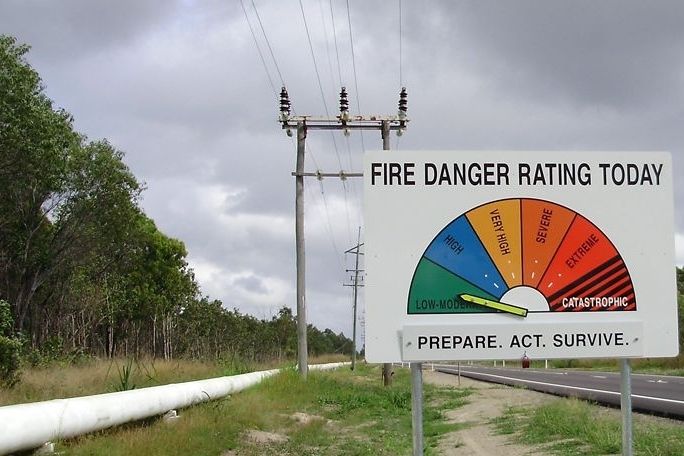Lesson summary
This lesson can be done in class or as an excursion to a local community emergency response group. Students begin by brainstorming who they can go to in the local community to find advice about local natural hazards, what questions they would ask and what hazard information they have seen already in the community. If on an excursion, students will listen to local advice and then reflect on their learning and their family’s preparedness. If in class, they will conduct a website review about natural hazards and then write a letter or monologue to inform their family of what they learnt and convince them to prepare for the natural hazard.
Alternatively, students will write a letter to the community emergency response group’s website with recommendations for improvement.
The lessons in this unit are designed to inform students about natural hazards in the local environment and ways to reduce risk, prepare, respond and recover from a disaster or emergency.
Learning intentions:
Students will...
- understand they can connect with local organisations to receive advice on natural hazards
- understand which natural hazards are present in their local area and what to do about them
- understand that information needs to be accessible to a diverse range of people to be effective.
Success criteria:
Students can...
- identify local people or organisations to ask for advice on natural hazards
- identify local natural hazards
- describe the local advice on how to prepare for natural hazards
- explain why it is important for all community members to prepare for natural hazards.
Lesson guides and printables
Lesson details
Curriculum mapping
Australian Curriculum content descriptions:
Year 7 Geography:
- Causes, impacts and responses to an atmospheric or hydrological hazard (ACHGK042)
- Present findings, arguments and ideas in a range of communication forms selected to suit a particular audience and purpose; using geographical terminology and digital technologies as appropriate (ACHGS053)
Year 8 Geography:
- Causes, impacts and responses to a geomorphological hazard (ACHGK053)
- Present findings, arguments and ideas in a range of communication forms selected to suit a particular audience and purpose; using geographical terminology and digital technologies as appropriate (ACHGS061)
Years 7 & 8 Health and Physical Education:
- Practise and apply strategies to seek help for themselves or others (ACPPS072)
- Investigate and select strategies to promote health, safety and wellbeing (ACPPS073)
- Evaluate health information and communicate their own and others’ health concerns (ACPPS076)
- Plan and use health practices, behaviours and resources to enhance health, safety and wellbeing of their communities (ACPPS077)
Years 7 & 8 Civics and Citizenship:
Syllabus outcomes: GE4-2, GE4-3, GE4-4, GE4-5, GE4-8, PDHPE4.2, PDHPE4.3, PDHPE4.6, PDHPE4.7, PDHPE4.8, PDHPE4.9, PDHPE4.10, PDHPE4.12, PDHPE4.13, PDHPE4.16
General capabilities: Literacy, Information and Communication Technology (ICT) Capability
Cross-curriculum priority: Sustainability
Relevant parts of Year 7 Geography achievement standards:
Students describe geographical processes that influence the characteristics of places and how the characteristics of places are perceived and valued differently. They explain interconnections between people and places and environments and describe how these interconnections change places and environments. Students present findings and arguments using relevant geographical terminology and digital technologies in a range of communication forms.
Relevant parts of Year 8 Geography achievement standards:
Students explain geographical processes that influence the characteristics of places and explain how places are perceived and valued differently. They explain interconnections within environments and between people and places and explain how they change places and environments. Students present findings, arguments and ideas using relevant geographical terminology and digital technologies in a range of appropriate communication forms.
Relevant parts of Years 7&8 HPE achievement standards:
Students investigate strategies and practices that enhance their own, others’ and community health, safety and wellbeing. They demonstrate skills to make informed decisions, and propose and implement actions that promote their own and others’ health, safety and wellbeing.
Relevant parts of Years 7&8 Civics and Citizenship achievement standards:
When planning for action, students take into account multiple perspectives, use democratic processes, and develop solutions to an issue. They identify ways they can be active and informed citizens in different contexts.
This lesson is part of the wider unit of work Disaster Resilience Education – Years 7 & 8
Time required: 75+ mins
Level of teacher scaffolding: Medium – facilitate class discussion, lead students in activities, plan excursion and liaise with community emergency response groups
Resources required
- Internet capable devices for student research
- Student Worksheets – one copy per student
Skills
This lesson is designed to build students’ competencies in the following skills:
- Communication
- Community engagement
- Critical thinking
- Digital literacy
- Collaboration
Additional info
These lessons were designed in consultation with the Australian Institute for Disaster Resilience.


Welcome back!
Don't have an account yet?
Log in with:
By signing up to Cool.org you consent and agree to Cool's privacy policy to
store, manage and process your personal information. To read more, please see
our privacy policy here(Opens in new tab).
Create your free Cool.org account.
Many of our resources are free, with an option to upgrade to Cool+ for premium content.
Already have an account?
Sign up with:
By signing up to Cool.org you consent and agree to Cool's privacy policy to
store, manage and process your personal information. To read more, please see
our privacy policy here(Opens in new tab).